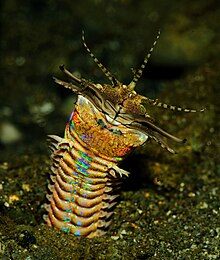Eunice aphroditois
| Eunice aphroditois | |
|---|---|

| |
| A burrowed Eunice aphroditois | |
| Scientific classification | |
| Domain: | Eukaryota |
| Kingdom: | Animalia |
| Phylum: | Annelida |
| Clade: | Pleistoannelida |
| Subclass: | Errantia |
| Order: | Eunicida |
| Family: | Eunicidae |
| Genus: | Eunice |
| Species: | E. aphroditois
|
| Binomial name | |
| Eunice aphroditois Pallas, 1788
| |
Eunice aphroditois is a benthic bristle worm of warm marine waters. It lives mainly in the Atlantic Ocean, but can also be found in the Indo-Pacific.[1][2] It ranges in length from less than 10 cm (4 in) to 3 m (10 ft).[3] Its exoskeleton displays a wide range of colors, from black to purple and more. This species is an ambush predator; it hunts by burrowing its whole body in soft sediment on the ocean floor and waiting until its antennae detect prey.[4] It then strikes with its sharp mouthparts.[5] It may also be found among coral reefs.
E. aphroditois is also known as the bobbit worm[6][7] or bobbitt worm.[8] The name is believed to be taken from the John and Lorena Bobbitt case;[9] however, another proposed reason is due to its jaw. It is sometimes called the sand striker.[8] Another name associated with them is trap-jaw worm, noted in 2021 to have been found among fossils near Taiwan dating back twenty million years.[10]
Description

These ambush predators have no eyes and five antennae on their head that are used to sense prey.[11] The body is covered by a hard exoskeleton.[12] The mandibles can be retracted inside the body and are responsible for striking and stunning prey; they are capable of snapping some prey in half.[13] Typically, E. aphroditois ranges from deep purple to black, along with metallic colors. The largest known specimen on record reached 299 centimeters (9.81 ft) in length,[3] making it the longest known member of the polychaete class. Despite these great lengths, the worms are slim, with the body only about 25.5 millimeters (1.00 in) wide.


Habitat
This species may be found prowling among the prey-rich environment of coral reefs, where its coloration allows it to blend in and its slim body enables it to hunt in tight places.[13] It inhabits a wide range of other habitats,[14] particularly sandy and muddy sediments, as well as around rocks and sponges.[13] It has been recorded at depths of up to 95 meters (312 ft).[7]
Diet and interactions
Eunice aphroditois senses passing prey with its antennae, seizes the prey with its mouth, and drags it into its burrow. To reduce predation risk, some fish engage in mobbing behavior, during which a group of fish will direct jets of water into the worm's burrow to disorient it.[4] This species is not only considered to be a carnivore, feeding on a plethora of species of fish, but it can also be considered an herbivore/omnivore, feeding on algae, as well as a decomposer, feeding on dead and decaying matter.[15]
Ancestral species may have exhibited the same hunting behavior 20 million years ago, according to fossil-records.[16]
Life-cycle
Like most of the class Polychaeta,[17] E. aphroditois is a sexually-reproducing organism that lacks external reproductive organs. During spawning, female polychaetes produce a pheromone that attracts males and causes them to release sperm; this in turn triggers the female to release eggs into the water, where fertilization occurs.[7] Few offspring survive to adulthood because often, the eggs are eaten by other animals or destroyed.
The lifespan of E. aphroditois is believed to be three to five years.[18]
Regeneration
Like many species of bristle worm, E. aphroditois can also reproduce asexually by splitting into multiple segments, then regenerating body parts such as the head or tail. This enables them to survive being attacked by predators.[19]
Aquaculture
While not commonly kept in aquaculture, individuals of E. aphroditois are occasionally found in home aquaria, where smaller specimens can evade detection by being transported into the tank in live rocks, where they then grow in size.[20] As E. aphroditois hunts fish, it cannot be kept as part of a community tank and should be removed when found, as it will deplete the aquarium's stock by direct predation.[21]
E. aphroditois can be difficult to remove from aquariums due to their abilities to split into new individuals when handled,[19] dig holes into rocks, and curl up and hide in small rocks, despite their length.[22]
References
- S2CID 85293536.
- ^ Fauchald, Kristian. "WoRMS- World Register of Marine Species".
- ^ ISSN 1349-2705.
- ^ PMID 27615670.
- ISBN 9780643065710.
- ISBN 0930118219.
- ^ a b c "Eunice aphroditois, bobbit worm". www.sealifebase.ca. Retrieved 2019-04-16.
- ^ a b Cormier, Zoe. "Snapping death worms can hide undetected for years". BBC Earth. Retrieved 14 January 2020.
- ISBN 9783925919565.
- ^ Black, Riley, Giant predatory worms lurked beneath the ancient seafloor, fossils reveal, National Geographic, January 21, 2021
- ISSN 0303-6758.
- ISSN 0024-4082.
- ^ a b c "Eunice aphroditois (Pallas 1788) - Encyclopedia of Life". eol.org.
- S2CID 251713054.
- PMID 28220886.
- PMID 33479265.
- S2CID 85774255.
- ISSN 0011-216X.
- ^ a b Stanton, Jenny (2013-10-24). "Bobbit worms 'split into sections to regenerate'". SurreyLive. Reach PLC. Retrieved 2023-03-12.
- ^ "Bobbit worm found at Woking aquatics store". BBC News. 2013-10-14. Retrieved 2022-09-01.
- ^ Callum. "Bobbit Worm". RockNCritters. Retrieved 2022-09-01.
- ^ Tung, Liz (2022-11-25). "The Bobbit Worm Chronicles: One man's epic battle against the sea's creepiest crawly". WHYY. Retrieved 2023-03-12.
